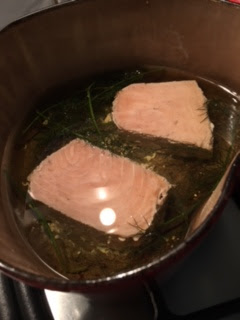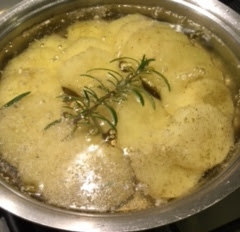 |
| Boule -The French Bread |
There are many types of bread that we could do. From the plain bread to flavoured bread, and also the speciality bread of the country origin, such as a Boule, it is around French bread as pictured.
Give Us Our Daily Bread is Beautiful Prayer. Daily Baking Bread Could Be Wonderful.
I do love baking bread, and recently I have learnt a lot about sourdough bread and the making of sourdough starter. Once a month to bake sourdough bread is not often enough, and the problem is feeding the sourdough starter to keep life is not easy, I might forget! At present, I have the starter sits in the refrigerator at least five weeks, so I am not sure that it is suitable for baking. In any case, I have to start to make it from scratch to get better bread.
My Home Baked Sourdough Fougasse
The next baking that I have in mind is Fougasse based on another recipe, it is a flat and pretty looking bread from Provence one of the regions of France. The Wikipedia says about Fougasse: In French cuisine, Fougasse is a type of bread typically associated with Provence but found (with variations) in other regions. Some versions are sculpted or slashed into a pattern resembling an ear of wheat.
This Fougasse that I am going to bake uses dried yeast and fermented dough which is prepared the night before. It is based on the recipe of Louis Vaussenat. It is added butter.
Two days to make the Fougasse, the first day is the preparation of fermented dough and the flavouring of the Fougasse, which is onions and bacon.
Day One: Fermented Dough
Ingredients: 100 g strong flour, a good pinch of salt
1/4 teaspoon dry yeast.
60 ml of water
- In a bowl, mix all the ingredients together to form a dough, place onto the bench and knead until fully developed. This should take 8-10 minutes.
- Place into a lightly oiled container, cover with plastic wrap and leave overnight to ferment - at least 12 hours.
150 g bacon trimmed and cut into thin slices
Salt and black pepper
- Heat a frying pan with a small amount of olive oil and lightly saute the onion and bacon. Season with salt and pepper.
- Remove from the heat and place onto a paper towel to absorb any oil. Place in a container to cool, cover and place in the fridge.
- Sieve the flour onto your work surface. Make a well and add the salt, fermented dough, yeast and butter (I said Oil instead)
- While mixing by hand, slowly add the water to the well.
- Mix or knead the dough by hand for 11 minutes and make sure that the dough is fully developed.
Add the pre-cooked onions and bacon and continue to knead - this will take a while to become incorporated.
- Lightly oil a bowl large enough to allow the dough to double in bulk. Put the dough in the bowl and cover with plastic. Leave in a warm place (25 degrees C) for 1 1/2 hours. By this time the dough should be nearly double in size.
- Gently knock back the dough in the bowl. This will deflate it slightly but will develop more strength. Cover again and leave for 30 minutes.
- Tip the dough out onto a lightly floured bench and, using a dough scraper, cut the dough into 4 pieces, at approximately 315 g
each. Mould each dough piece into a cob shape b cupping your hands around and moving in a circular motion, pulling the skin tightly over the dough. Don't over do it though or the surface will rip, and this will spoil the appearance of the finished product. The final shape will look like a smoothDivide into Four
Ball, but with a rough, scrunched-up bottom. Lay the pieces back on the floured bench and cover with a proofing cloth or plastic. Give an intermediate proof of 15 minutes.Final shape Covering with a proofing cloth - Uncover the dough and then, on a floured bench, use a rolling pin to roll each dough piece into an oval shape, approximately 200 mm long by 100 mm wide and 1mm thick.
- Using a sharp knife or razor blade, cut 3-4 diagonals down each side, 50 mm in length and all the way through, then pull each cut apart to create a wide-open effect. Repeat for the remaining dough pieces.
- Place each dough pieces onto a baking tray lined with baking paper, 2 per baking tray. Allow about 50 mm between each piece of dough, keeping the cut wide open. The wider, the better.
Rolling the dough and ready for shaping Shaping and making pretty
Final Proof and Baking - Cover each baking tray with plastic and put in a warm place. Allow to final proof for 30-40 minutes or until fully proofed. If desired, lightly spray the dough with warm water, sprinkle with dried herbs.
- Place the baking trays into a preheated oven set at 230-240 degrees C and bake for 15-18 minutes. Fougasse should be well cooked so that they are crisp and not pale.
- Remove from the oven and, if desired, immediately brush lightly with olive oil. Cool on a wire rack.


 |
| The dough after the first proofing |
 |
| Freshly Baked Fougasse |
(I forgot to brush with olive oil, for the freshly baked Fougasse). The Fougasse looks a little bit dull, but it is alright.
Fougasse is the best to be eaten at the day it is baked, delicious, warm straight of the oven. However, it freezes well, when you want to eat it, take it out from the freezer and heat up in the oven to crisps up.
This recipe is very friendly, you cannot go wrong, and at the end result the Fougasse is delicious and baked beautifully. But I found that Fougasse made out with sourdough starter has more flavour.
This recipe is very friendly, you cannot go wrong, and at the end result the Fougasse is delicious and baked beautifully. But I found that Fougasse made out with sourdough starter has more flavour.
I had great fun to bake this bread, and I was lucky enough to share it with my daughter and her husband Tristan who came home to visit us.
Crafted Fougasse is beautiful. A few of these bread, the pretty Fougasse sit on a plate adorns the rest of the spread, it makes a beautiful table.
Fougasse with no Butter
I decided to add oil instead of butter for this Fougasse because Tris is dairy intolerant. But a big mistake was I made him a coffee cake. Oh dear, I forgot that it has butter in it. No Cake!
After a good night sleep, I had this bright and lovely idea. Loukoumades are Greek doughnut (fried in oil of course) it is suitable for him. It was not too late to wish him a happy birthday with beautiful Loukoumades which easily prepared (the whole process was only 22 minutes or even less, from start to finish)
 |
| Loukoumades for Tristan |
 |
| One Loukoumades is Enough |
Fougasse without butter, and I cooked Potato Fondant without butter. No Butter still Better!
Brush with olive oil, the freshly baked Fougasse (hot and fresh out from the oven)! I baked one this morning, Sunday the 25 of June. And indeed it looked better and hopefully taste good too.
Baking the Fougasse with Dried Herbs
 |
| Beautiful and Crisps Fougasse. |
The recipe says added butter, but added oil was good too. It worked well.
Have Fun Baking the Fougasse. Enjoy the Recipe.
Until Next Post
Susy



















































